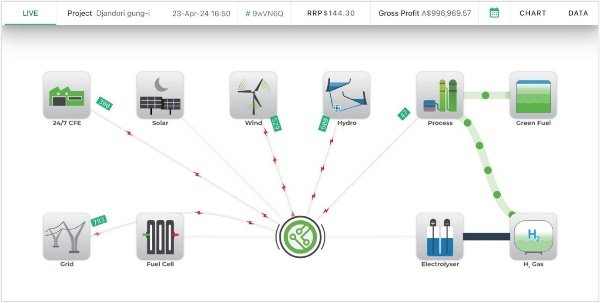Superhybrid™ is a novel combination of well-known technologies. Together they do the job of a coal baseload power station and a gas peaker, while also providing transport fuels – and all without a carbon footprint.
We integrate wind, solar and sustainable biomass with long-duration energy storage, electrolyser and green fuels production in an asset ecosystem called the Superhybrid™.
Our Advanced Energy Storage Optimisation Program (AESOP) orchestrates each asset to create an optimal outcome in that ecosystem.
The Superhybrid delivers reliable 24/7 carbon-free energy and green fuels. Able to mitigate revenue uncertainty through long-term contracts, it monetises merchant opportunities on energy trading, frequency control and grid support services.

Industry and community require a constant feed of electricity. Wind energy varies with wind conditions and solar energy is only available during sunny days. 24/7 Carbon-Free Energy (24/7 CFE), as delivered by the Superhybrid™, means a constant stream of renewable electricity that can be contracted and relied on all day every day. 24/7 CFE is renewable energy matched with demand every hour of every day.
The growth on the 24/7 CFE market is driven by demand from some large global corporations and policy settings in the EU and US.
When renewable energy is abundant, a Superhybrid™ turns it into hydrogen which further along the line can be transformed into green fuels like methanol or Sustainable Aviation Fuel (SAF). The green fuel production of a Superhybrid is a combination of biofuel and e-fuel, providing further flexibility to optimise the production assets as a flexible load on the electricity market while supporting constant fuel supply contracts.
We also develop stand-alone production plants using sustainable biomass as biofuel. These facilities respond more quickly to the urgent need to decarbonise the transport sector. Further along the line, it is envisaged they will be incorporated into a Superhybrid ecosystem, which takes longer to develop.
Electricity demand changes each day. It typically peaks at breakfast and dinner-time each day. Fast responding generators can provide the power to meet these peaks. With a Superhybrid™ system, electricity can be diverted from various system components to meet this peak demand. Energy storage capacity can be used to shift solar energy on into the evening, profiting from the price difference.
Frequency control services markets are critical to maintaining the balance between consumption and generation in the electricity grid within an acceptable range (around 50 Hz). Superhybrid™ assets can bid their available capacity into frequency markets and be paid for supporting this important grid feature.
Superhybrid™ assets can also offer a variety of other grid support services at their grid connection points. that are essential for a resilient energy system. These include voltage support, capacity support and black-start service for restarting the power system after a major blackout. These services are essential for a resilient energy system.
Some Superhybrid™ processes produce useful by-products. Green oxygen is a by-product of hydrogen production created as water is split into hydrogen and oxygen through electrolysis. Methanol production also creates biochar which is valuable for improving soil quality in agriculture.
A Superhybrid may also generate excess green certificates that relate to the energy originating from renewable sources. These can be sold to the market as uncertified peaking power, frequency control or grid services.
The AESOP (Advanced Energy Storage Optimisation Program) technology developed and owned by Sunshine Hydro is the cornerstone that enables seamless and efficient operation of our Superhybrid™ energy systems.
The software has two distinct roles. Initially AESOP guides the design of assets and commercial contracts. After commissioning, it optimises the operations and interacts with each asset’s control system.

AESOP works with different energy storage technologies including pumped hydro and batteries. AESOP is able to model production of green fuels such as methanol and sustainable aviation fuel (SAF).
AESOP works with live data and forecast storage levels, market pricing and wind to direct each asset so it runs optimally in each and every trading interval. In Australia, that means every five minutes.
We run AESOP in real time as a Digital Twin for each of our advanced development projects, gathering valuable information about how these assets would perform if they were operational today.
Using comprehensive historical data, AESOP provides engineers and IT professionals with tools to trial variable project design parameters. Results allow investment decisions to be validated with a high level of confidence.
Features:
AESOP applies multiple real-time optimisations to distribute incoming renewable energy to different parts of the Superhybrid. This tailors operations so they meet contractual requirements. At the same time, AESOP maximises revenue through opportunistic trading within contestable wholesale markets.
Features:

Copyright © Sunshine Hydro | All Rights Reserved | Made by a Yakk